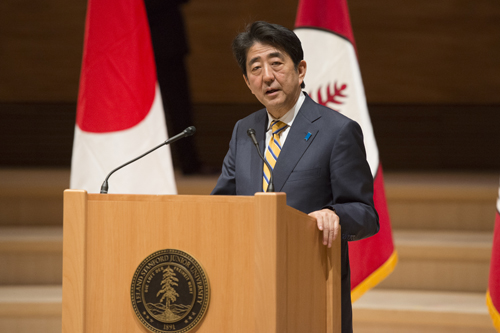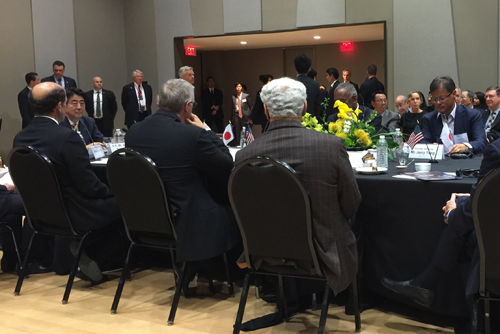Prime Minister Shinzo Abe’s Visit to Silicon Valley
- 日時
2015年4月26日 (日) 7:00 pm – 8:00 pm
By Dr. Daniel Okimoto, Chair of the USJC Board of Councilors

Prime Minister Shinzo Abe’s visit to Washington DC, his Press Conference with President Barack Obama, and his speech before a joint session of the US Congress were path-breaking in both policy substance (the New Joint Defense Guidelines; and progress on TPP negotiations) and political symbolism (a clarion affirmation of Japan’s commitment to the U.S.-Japan Alliance).
Similarly, Prime Minister Shinzo Abe’s visit to Silicon Valley can be considered historic in terms of its economic symbolism and policy substance. Although Prime Minister Toshiki Kaifu stopped briefly in San Francisco in 1989, this was the first official visit by the Japanese head of state to Silicon Valley, the cradle of entrepreneurship and innovation.
The Prime Minister’s day in Silicon Valley included meetings with Silicon Valley legends (such as Jerry Yang, Jack Dorsey, John Thompson, Mark Zuckerberg, Elon Musk, and Larry Ellison), a public speech and a private dialogue at Stanford University, stops at flag-ship corporations (Tesla Motors and Facebook) and at the Gladstone Institute at the University of California at San Francisco (where he met with Nobel Laureate, Dr. Shinya Yamanaka), and a meeting in San Francisco with Governor Jerry Brown, with whom he discussed the $68 billion California High-Speed Rail Project.
In his public address at Stanford University, Prime Minister Abe announced a new policy initiative, which he called a “Bridge of Innovation between Silicon Valley and Japan” (in Japanese: “Kakehashi”). The proposed “bridge” incorporates the essential pillars of the “Silicon Valley-Japan Platform” which the U.S.-Japan Council and the Rebuild Japan Initiative Foundation have launched; specifically:
**Incubators/accelerators to select, train, and globalize the most promising small-medium enterprises in Japan by bringing them to Silicon Valley for intensive mentorship; over a five year, the goal is to incubate 200 small-medium firms in such fields of Japanese competitive strengths as design, transportation, health care, robotics, and retail.
**Clearly focused, specialized conferences, briefings, meetings, and seminars, bringing together Japanese and American experts in diverse spheres of technology, such as “fin tech” (financial technology) and “med tech” (medical technology)
**Training and collaboration with leading-edge, multi-disciplinary centers of research and development at Stanford, such as the BioDesign Center and the School of Design; Prime Minister Abe mentioned the establishment of a Stanford BioDesign Center in Japan, with the participation of three leading Japanese universities: Tokyo University, Osaka University, and Tohoku University.
**Absorbing the Silicon Valley culture of creativity, disruption, and risk-taking, including also the acceptance of failure and second-chances to rebound from initial failure.
In both his public address and private dialogue, Prime Minister Abe made reference to Japan’s past tradition of entrepreneurial accomplishment, citing such examples as Matsushita, Sony, and Honda. With pride, he pointed out the enduring strength of Japanese technology, suggesting that it represented an enormous asset whose full potential might be unleashed by making changes in policies, institutions, and culture.
Prime Minister Abe’s statements and his overall attitude conveyed a feeling of optimism about Japan’s potential to transform its business practices in ways that would make the economy more adaptive, nimble, and innovative.
His new policy initiative, a “Bridge of Innovation between Silicon Valley and Japan”—“Kakehashi”—will now carry the full weight of support from the Abe Administration and the Japanese government. The significance of this imprimatur can scarcely be overstated.

The seven distinguished Silicon Valley leaders, who participated on the Roundtable, included Jerry Yang, co-founder of Yahoo!; Jack Dorsey, co-founder of Twitter and Square; John Thompson, Chairman, Microsoft; Romesh Wadhwani, founder, Symphony Technology Group; Paul Yock, founder and director, Stanford Center for BioDesign; and Bruce Sewell, Apple, General Counsel (standing in for Tim Cook, Apple, CEO, who had to withdraw at the last-minute); and John Roos, former US Ambassador to Japan.
It was an experienced and knowledgeable group of Silicon Valley pioneers assembled to give Prime Minister Abe the benefit of their deep insights into ways in which Japan can unlock the potential of its technological and economic assets.
Among the stimulating insights and advice that the Silicon Valley leaders communicated to Prime Minister Abe were the following:
- Japan ought to establish a Ministry of Entrepreneurship & Innovation;
- Large Japanese corporations need to learn how to deal more synergistically with small start-ups;
- Large Japanese corporations should focus on ways of incentivizing employees to innovate and to spin out new companies; entrepreneurship and innovation must not be confined to small-medium enterprises;
- Japan must increase the number of students sent to study in the United States (in order to offset the slump in recent numbers);
- Regulatory policies should be streamlined so as to allow financial transactions to be consummated over mobile devices;
- To amplify the concept of acceptable failure, Prime Minister Abe is in a unique position to emphasize that his first term in office as Prime Minister ended in failure; but given a second-chance, he has succeeded, because he has learned from his mistakes the second time around.
- What Japan must change, above all, is its business culture, one that has been deeply embedded by decades of pace-setting success during the second half of the twentieth-century. There needs to be a shift towards sensible risk-taking, nimbleness, speed, and more efficient use of capital and labor.
By visiting Silicon Valley, Prime Minister Shinzo Abe has made history as the first Japanese head of state to prioritize the goal of connecting Japan more expansively to the entrepreneurial and technological vitality of Silicon Valley. Other heads of state, grasping the significance of his visit, could very well follow suit.
Our hope is that the visit on April 30th will set a precedent for future Japanese heads of state as well as other Japanese national and prefectural leaders. It would be optimal for Prime Minister Shinzo Abe to follow-up this visit with several others. He appears likely, after all, to remain in office until the end of this decade.
–Dan Okimoto